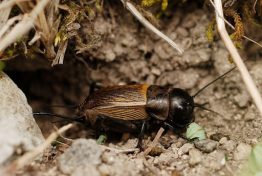Crickets
 Order: Orthoptera (crickets, grasshoppers, katydids, etc.)
Order: Orthoptera (crickets, grasshoppers, katydids, etc.)
Family: Gryllidae
How to identify:
As with most insects, crickets have six legs and four wings. In NJ, crickets are usually dark brown, black, or beige. They have long, strong back legs for jumping, long antennae that are sometimes longer than their bodies, and typically grow ¾ to 1 inch long (Borror & White, 1998).
Crickets are often mistaken for grasshoppers or katydids. While antenna length varies greatly in grasshoppers, some common ones to NJ have short antennae, tend to be bigger than crickets, and are commonly green or brown. Grasshopper wings are held tent-like over the back, so they come to a point (especially in the back beyond the abdomen). Katydid species in NJ are bright green, have antennae longer than their bodies, longer legs, and their wings are held tent-like high over their backs (Borror & White, 1998).
Advanced ID: Antennae are slender and usually as long as or longer than body. Tympana present on base of front tibia. Body flattened, tarsi 3-segmented, and ovipositor usually long and cylindrical. Long and feeler-like cerci; wings usually flat over back. Forewing of females: thickened & leathery. Forewing of males; large membranous areas and often wider (Borror & White, 1998).
Ecology
Metamorphosis Type: Simple metamorphosis. Nymphs (between the egg and adult stages) are wingless and look like small versions of adult crickets.
Geographic Range: Crickets are found on all continents except Antarctica. There are more than 120 species in the United States alone (Renico,2019).
Habitat: Crickets are generalists and live in many habitats- forests, grasslands, wetlands, caves, beaches underground and even in human homes!
Trophic Level: Omnivores
Food: Crickets are generalists and will eat a broad range of food- plants, seeds, and other insects. They use their mandibles (strong, movable mouthparts) to tear food into smaller pieces.
Why should we care?
Human Uses: Crickets help break down plant and animal material and in the process help to renew minerals in soil; they are also an important food source for other animals. Some cultures even consider crickets a delicacy!
Conservation Status: As of today, house crickets are classified as “Not Endangered” according to the IUCN (Kidadl,2021).
Did you know?
-
Male crickets are well-known to “sing” by rubbing their wings together in an attempt to court females.
Images Cited
Photo 1: Gilles San Martin. 2010. Creative Commons License | Link
Photo 2: Tom Friedel. 2008. Creative Commons License | Link
Photo 3: Quartl. 2010. Wiki Commons | Link
Photo 4: Jesse’s Photography. 2018. Creative Commons License | Link
Photo 5: Allison Day. 2015. Creative Commons License | Link
Researcher’s Biography
Guillermo Gonzalez
Completed this research within Dr. Shelly Thomas’ Entomology course
Suggested Citation:
Gonzalez, Guillermo. (2022). Crickets. Rowan University Arboretum. https://arboretum.rowan.edu/learn/explore-insects/crickets/
Questions to Explore
- How does noise pollution affect cricket populations and their reproductive success?
- What factors influence cricket survival, reproduction, and development, and how does this impact other species?
- How can crickets be used as model organisms for studying developmental biology, regeneration, and aging?
- How are crickets helpful to humans?
- How do crickets appear in Native American mythology, folklore, or creation stories?
- How have contemporary Native American artists or storytellers been influenced by the symbolic or cultural significance of crickets?
Citations
Borror, D. J., & White, R. E. (1998). A field guide to the insects of America north of Mexico, 2nd edition. Boston: Houghton Mifflin Harcourt.
Did you know? 15 Incredible House Cricket Facts. Free Ideas For Family Fun & Learning. (n.d.). Retrieved December 10, 2021 | Link
Management, I. P. (2020, September 10). Cricket identification, habits & behavior: Isotech Pest Management. Isotech Pest Management – Commercial Pest Control in Los Angeles CA. Retrieved December 10, 2021
| Link
Renico, L. (2019, November 22). What kind of environments do crickets live in? Sciencing. Retrieved December 10, 2021
| Link





